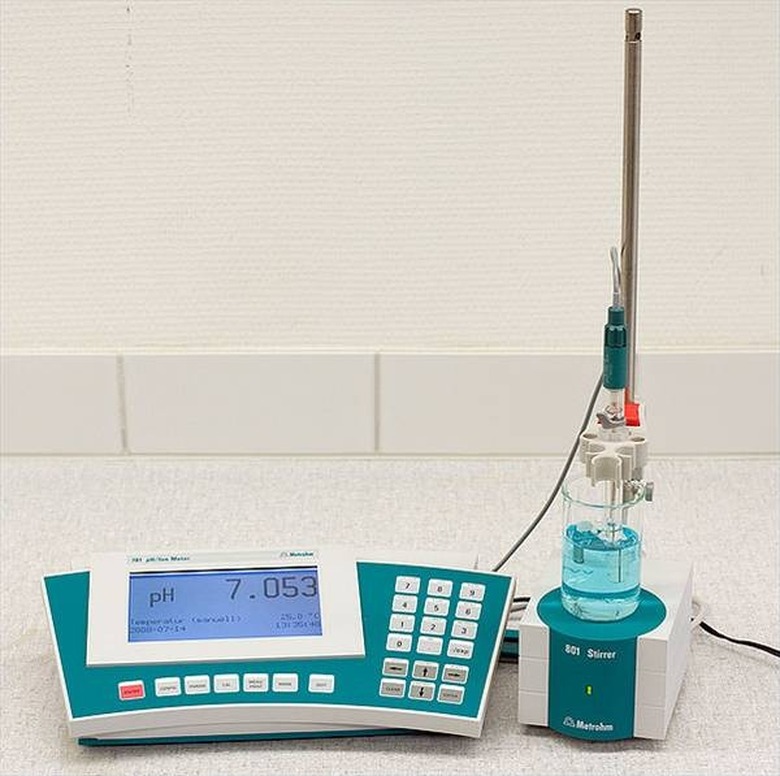How To Calibrate A pH Meter
A pH meter is an electronic device that measures the acidity or alkalinity of substances. Calibration of a pH meter must be completed before use.
What Does pH Mean?
What Does pH Mean?
pH is a measure of hydrogen ion activity in aqueous solutions. In pH, the p is –log10 and the H is hydrogen ion activity. Therefore pH = -log10aH+, where a is the activity of the hydrogen ions, which also may be considered the hydrogen ion concentration. This is a logarithmic scale, and any change in one pH unit is a tenfold difference in the concentration of hydrogen ions.
Acid solutions have a pH less than 7; battery acid is about a pH of 0, and a tomato is a pH of 4. Basic solutions have a pH greater than 7; baking soda is about a pH of 9, and drain cleaner is a pH of 14. The pH of 7 is considered neutral. If you want to take a substance and determine what its pH is, a pH meter is a very useful tool. However, in order for it to be accurate it has to be calibrated using buffers, which are substances that have a known pH.
Where to Find Equipment
Where to Find Equipment
pH meters, distilled water, lint-free tissues (such as Kimwipes) and the necessary buffer solutions are available at chemical, plant and/or fish aquarium supply stores. Reusing buffer solutions may lead to poor performance of the pH probes. It is best to use a vessel that fits the probes but requires the least amount of fresh solution.
How a pH Meter Works
How a pH Meter Works
There are two electrodes in a pH meter, and both are submerged into the solution. One of the electrodes is a glass electrode probe that emits a small voltage and measures the quantity of hydrogen ions attracted to it. The reference probe is electrically neutral. The charge difference between the two probes displays as a pH measurement on the meter.
pH meters measure the electrical potential produced by a solution and then compare it to known solutions. Calibration of a pH meter is done using measuring substances with known pH levels, called buffers, and setting the pH measurements to those levels on the pH meter.
The pH meter uses the calibration measurements as a guide in the measuring of other substances. pH meters lose some of their accuracy with every use, and the calibration of a pH meter must be completed often if not daily.
Calibration of pH Meters
Calibration of pH Meters
Use the following four steps in the calibration of pH meters.
Step 1: Clean the Electrodes
Step 1: Clean the Electrodes
If working with laboratory equipment and chemicals, it is important to wear proper safety equipment, such as gloves and safety glasses. After turning on the power to the pH meter, take the pH meter electrode from its storage solution and rinse with distilled water. Wipe it clean with a lint-free tissue.
Step 2: Calibrate With the pH 7 Buffer
Step 2: Calibrate With the pH 7 Buffer
Submerge the rinsed electrode into the pH 7 buffer solution. Press the calibrate button and wait for the pH icon to stop flashing. If the pH reads 7, accept; if it does not, edit the entry using the keypad on the instrument. Rinse the electrode again with distilled water and wipe clean with a lint-free tissue.
Step 3: Calibrate With the pH 10 Buffer
Step 3: Calibrate With the pH 10 Buffer
Now submerge the rinsed electrode into the pH 10 buffer. Press the calibrate button once the pH icon stops flashing. If the pH reads 10, accept; if it does not, edit the entry using the keypad on the instrument. Rinse the electrode with distilled water and wipe with a lint-free tissue.
Step 4: Measure the pH of Solutions
Step 4: Measure the pH of Solutions
The pH meter is now ready to measure the pH of other substances. Be sure to submerge the electrode and rinse with distilled water in between multiple samples.
Cite This Article
MLA
Kozlowski, Rosann. "How To Calibrate A pH Meter" sciencing.com, https://www.sciencing.com/calibrate-ph-meter-4796148/. 10 February 2020.
APA
Kozlowski, Rosann. (2020, February 10). How To Calibrate A pH Meter. sciencing.com. Retrieved from https://www.sciencing.com/calibrate-ph-meter-4796148/
Chicago
Kozlowski, Rosann. How To Calibrate A pH Meter last modified March 24, 2022. https://www.sciencing.com/calibrate-ph-meter-4796148/
